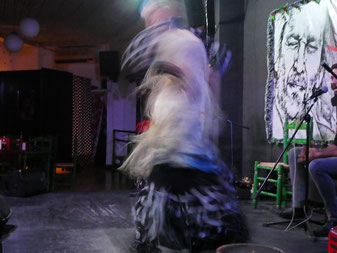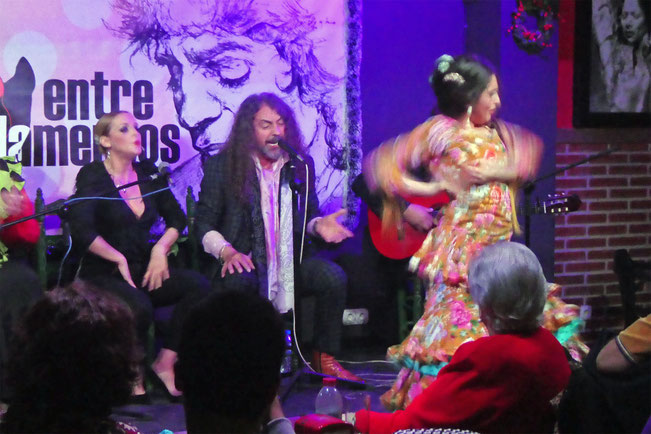
I love watching flamenco performance. While there’s good flamenco at home in Australia, I’m now in the home of flamenco – Andalusia, in southern Spain, so it’s great to get to see it here.
We’ve landed in a good location for flamenco here in Aguadulce – there is an intimate flamenco venue here in the entertainment precinct next to the harbour; it’s called Entre Flamencos del Puerto.
We’ve been to Entre Flamencos del Puerto four times while we’ve been in Aguadulce, and it’s been great to have excellent flamenco so easily available.
This is the very Spanish entry to Entre Flamencos del Puerto – white-wash walls, Spanish flags, an arch that imparts a cave-like quality, lots of potted geraniums, a wine barrel to put your glass on, and a rather secretive-looking dark wooden door as befits the slightly underground character of flamenco:
Here’s a closer view of the cute potted geranium mounted on the window grill in front of Entre Flamencos:
Entre Flamencos is a tiny venue that would seat maybe 100 people. As we are here in the middle of winter it’s very quiet, and there are only usually 20-30 people in the audience. I think in the summer it runs as a theatre restaurant, but now they just serve drinks and tapas. With such a small audience it’s easy to get a seat close to the stage with a good view. Here’s one of the dancers in action, viewed over my beer glass:
Here’s a short video of her dancing:
These people are other performers at Entre Flamencos:
The young woman on the left, Claudia "La Debla", is only fourteen years old, and she is a superb dancer!
The man on the left is playing a cajon, a percussion instrument originally developed from discarded shipping crates by African slaves in Peru. It was introduced into Spain in the 1950s, so it’s a relatively new but popular accompaniment to flamenco music.
Flamenco is best known for its dancers, but singing, hand percussion, and guitar playing are equally important parts of the tradition. The flamenco singing style is usually mournful and intense. This is a flamenco singer at Entre Flamencos:
Flamenco in Almería
Flamenco is also performed at several interesting and intimate venues in the nearby city of Almería.
The Spanish lifestyle tends to start late and to run into the early hours of the next morning. For historical reasons, flamenco has a bit of a rebellious and subversive feel to it, so it starts particularly late; – usually flamenco performances are scheduled to start at ten pm and go until the early hours of the morning, but they don’t usually get going until 10.45pm or so.
Unfortunately, and inexplicably given the Spanish lifestyle, buses from Almería to Aguadulce stop running in the late evening, so we have to catch a taxi home if we wish to see a flamenco show at one of the small venues in Almería, which makes a bit more complicated and expensive. As we really enjoy the easily accessible performances in Aguadulce, we haven’t made the effort to get into any of the small venues in in Almería.
We have been to one performance in Almería, not at one of the intimate little venues, but at the Teatro Cervantes, a large formal theatre. This performance was intended to be accessible to children, so it started uncharacteristically early, at 9pm.
Many of the performers from Entre Flamencos at Aguadulce performed at the show, plus a highly acclaimed and well known male dancer, Paco Fernandez. The entire show was officially videoed and uploaded to Facebook. Unfortunately, the quality is appalling, but if you’d like to see some of the amazing dancing in the video you can find it on Facebook here.
You can find Claudia "La Debla" at 1 hour 25 minutes, Paco Fernandez at 49 minutes, and both of them dancing together with another dancer at 23 minutes.
Paco Fernandez has also danced at one of the intimate venues that we didn’t get to in Almería, La Canastera. Here’s a much better video (not by me) of him at that performance (the dancing starts at 1 minute):
Videoing the performance
You may be surprised that I videoed a performance from the edge of the stage at Entre Flamencos, and you may have seen in the video that I wasn’t the only person doing this. In Australia, you would expect to be glared at and tossed out if you did that; but in Spain it’s the perfectly normal thing to do. I only did it after I had seen many other people doing it, and I put the acceptance down to it being a small and club-like venue.
However, when we went to the Teatro Cervantes, a large, formal theatre in Almería, I was amazed to see maybe more than a hundred mobile phones being used to video the performance, their patches of light dotted all over the audience. A woman sitting in the seat in front of me held her phone up over her head right in front of my face. She was shocked and affronted when I indicated that I wanted her to remove it! Shortly after that a person two rows down did the same thing, so I gave up on my seat and went and stood in the side aisle for the rest of the performance, which proved to be an excellent place to watch from! So thanks to the videographers for giving me the excuse!
Street flamenco in Granada
Some of my favourite Flamenco in Spain was by street performers in Granada. We came across this group twice in Granada, once in front of the Catedral de Granada, and again in Plaza Nueva. Here's a short video compilation of their dancing:
These young men were led by a woman who made a speech before they started that indicated that they were students, and she was their teacher. (At least, that’s what I made of it with my limited ability to understand Spanish.)
As they were busking, the hat went round after they had finished. They were very popular, and I could see that they were impressed by the number of euros in the hat when it came back to them!
Tags
If you enjoyed this blog post, you can find related posts under these headings:
Previous post:
< Previous post
Next post:
future post >
Share this The Journey and the Destination post using your favourite social media:
Would you like to add something, or ask a question? Add a comment below (you can leave the 'Website' field blank):





